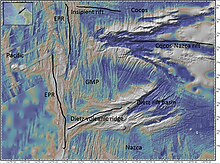User:TaoCo/GalapagosMicroplateSandbox

The Galapagos Microplate (GMP) is a geological feature of the oceanic crust located offshore of the west coast of Columbia, South America at 1°50' N. The GMP is collocated with the Galapagos Triple Junction, which is an atypical ridge-ridge-ridge triple junction. At the Galapagos Triple Junction, the Pacific Plate, Cocos Plate, and Nazca Plate meet incompletely, forming two counter-rotating microplates at the confluence of the Cocos-Nazca, Pacific-Cocos, and Pacific-Nazca spreading ridges[1].
Geological Evolution
[edit]Before the formation of the Galapagos Microplate, the Galapagos Triple Junction was a conventional ridge-ridge-ridge junction. The history of the microplate can be traced back to 1.4 Ma (million years ago), as evidenced by the trace of the southern triple junction ridge on the Pacific plate that created the southern boundary of the Galapagos Microplate. At that time, the southern boundary of the microplate was then starting to form by an active hotspot located beneath the southern tip of the East Pacific Rise. The hotspot rifted from the Pacific plate to the Nazca plate at approximately 1.2 Ma and a seamount chain began to develop on the Nazca Plate. This boundary is now known as Dietz Deep Volcanic Ridge, which extends to the northeast and grows at a velocity of 39 mm per year. The Dietz Deep Ridge terminates at the Dietz Deep Basin, an extensional feature with high elevational relief. The seamounts have been volcanically active with ongoing eruptions and continue to uplift the Dietz volcanic ridge.
The shape of the East Pacific Rise has varied with the changing of triple junction location. At approximately 1.5 Ma, the East Pacific Rise between the southern and northern triple junctions was convex towards the west. Over time, the axis of the East Pacific Rise straightened and the southern triple junction began to migrate southward.[2]
Structure
[edit]The entire Galapagos Microplate, which covers an area of 13,000 km², was formed to accommodate the motions of three major moving plates. The microplate is divided into two regions between north (Northern Galapagos Microplate) and south (Galapagos Microplate). The Galapagos Microplate is bounded by the Dietz volcanic ridge at 1°10'N, south of the Cocos-Nazca Ridge, and the Northern Galapagos Microplate (NGMP) is bounded by the Incipient Ridge at 2°40'N, north of Cocos-Nazca Ridge.[1][3] The westward propagating and slowly diverging Cocos-Nazca Ridge cuts between the two sub-plates toward the East Pacific Rise. However, the tip of Cocos-Nazca Ridge does not fully meet the East Pacific Rise[4] and, in fact, the westerly propagating Cocos-Nazca Ridge generates secondary transient rifts by shear stresses.[5][6] The tip of the Cocos-Nazca ridge has maintained a distance of 50 km from the East Pacifc Rise and slightly moved its position into the eastern part of the microplate due to clockwise rotation of the GMP.
Motion of the Galapagos Microplate and Northern Galapagos Microplate
[edit]Galapagos Microplate
[edit]Current estimates of the microplate motion may be inaccurate because the limited observational data set is too small for the large vector-based calculation assumptions. That said, the estimated rotational pole is located at 1.4°S, 99.8°W, 400 km southeast from the center the microplate and 350 km from its closest boundary. Motion is counter-clockwise at 6°/Myr[3]. This rate is in agreement with the northerly strike of the Pacific-Galapagos abyssal hills.
Northern Galapagos Microplate (NGMP)
[edit]The wedge-shaped Incipient Ridge characterizes the entire motion of the NGMP, as evidenced by recent magmatic activity and magnetic anomaly profiles. The eastern end of the Incipient Ridge is detected cutting through the north-south trending abyssal hills, and both bathymetric and magnetic data have shown recent magmatism along this ridge, supporting the idea that a counterclockwise pivot is located here. The rotation of the NGMP can be understood as clockwise-rotating blocks dragged by shear stresses from plate edges.[7]
Tao, does this describe the motion of the combined plate? Or just the NGMP? Or just the southern microplate? I think claiming 6°/Myr is confusing since you mention in a previous section that the NGMP is rotating counterclockwise. These are probably different rotations, but you need to explicitly say so because your reader will not understand. What measurements were used to make the calculation? You don't have to describe the method, just mention where the data come from. Erik (talk) 20:37, 6 June 2017 (UTC)
References
[edit]- ^ a b Emily M. Klein, Deborah K. Smith, Clare M. Williams & Hans Schouten (24 February 2005). "Counter-rotating microplates at the Galapagos triple junction". NATURE. 433: 855.
{{cite journal}}: CS1 maint: multiple names: authors list (link) - ^ Smith, Deborah K.; Schouten, Hans; Montesi, Laurent; Zhu, Wenlu. The recent history of the Galapagos triple junction preserved on the Pacific plate. Earth and Planetary Science Letters, June 2013, Vol. 371-372, pp.6-15
- ^ a b Lonsdale, Peter (November 10, 1988). "Structural Pattern of the Galapagos Microplate and Evolution of the Galapagos Triple Junctions". Journal of Geophysical Research. 93: 13551–13574.
- ^ Smith, D. K., H. Schouten, W. Zhu, L. G. J. Montési, and J. R. Cann (2011) (November 2011). "Distributed deformation ahead of the Cocos-Nazca Rift at the Galapagos triple junction". Geochem. Geophys. Geosyst. Vol.12(11).
{{cite journal}}:|volume=has extra text (help)CS1 maint: multiple names: authors list (link) CS1 maint: numeric names: authors list (link) - ^ Garrett A. Mitchell, Laurent G.J Montesi, Wenlu Zhu, Deborah K. Smith, Hans Schouten (8 June 2011). "Transient rifting north of the Galapagos Triple Junction". Earth and Planetary Science Letters: 461–469.
{{cite journal}}: CS1 maint: multiple names: authors list (link) - ^ Smith, D. K., H. Schouten, W. Zhu, L. G. J. Montesi, and J.R. Cann(2011). "Distributed deformation ahead of the Cocos-Nazca Rift at the Galapagos triple junction". Geochem. Geophys. Geosyst. 12: 11 November 2011.
{{cite journal}}: CS1 maint: multiple names: authors list (link) CS1 maint: numeric names: authors list (link) - ^ Schouten,H.,Klitgord, K. D.&Gallo, D. G. Edge-driven microplate kinematics. J. Geophys. Res. 98,6689-6701 (1993).
